The Impact of Altimetry Corrections of Sentinel-3A Sea Surface Height in the Coastal Zone of the Northwest Atlantic
Abstract
1. Introduction
2. Materials and Methods
2.1. Data
2.1.1. Altimeter Products
2.1.2. Sea Surface Height Anomaly Time Series
2.1.3. Quality Control
2.2. Analysis Methods
3. Results
3.1. Range and Geophysical Corrections
3.2. Retrackers
3.2.1. Comparison of Retracked Sea Surface Height Anomalies
3.2.2. Variance of Sea Surface Height Anomalies
4. Discussion
5. Conclusions
Supplementary Materials
Author Contributions
Funding
Data Availability Statement
Conflicts of Interest
References
- Cazenave, A.; Palanisamy, H.; Ablain, M. Contemporary sea level changes from satellite altimetry: What have we learned? What are the new challenges? Adv. Space Res. 2018, 62, 1639–1653. [Google Scholar] [CrossRef]
- Fletcher, K. Sentinel-3 ESA’s Global Land and Ocean Mission for GMeS Operational Services (ESA SP-1322/3, October 2012); European Space Agency: Noordwijk, the Netherlands, 2012. [Google Scholar]
- Vignudelli, S.; Birol, F.; Benveniste, J.; Fu, L.-L.; Picot, N.; Raynal, M.; Roinard, H. Satellite Altimetry Measurements of Sea Level in the Coastal Zone. Surv. Geophys. 2019, 40, 1319–1349. [Google Scholar] [CrossRef]
- Dufau, C.; Martin-Puig, C.; Moreno, L. User Requirements in the Coastal Ocean for Satellite Altimetry. In Coastal Altimetry; Springer: Berlin, Germany, 2011; pp. 51–60. [Google Scholar] [CrossRef]
- Scozzari, A.; Gómez-Enri, J.; Vignudelli, S.; Soldovieri, F. Understanding target-like signals in coastal altimetry: Experimentation of a tomographic imaging technique. Geophys. Res. Lett. 2012, 39. [Google Scholar] [CrossRef]
- Roesler, C.J.; Emery, W.J.; Kim, S.Y. Evaluating the use of high-frequency radar coastal currents to correct satellite altimetry. J. Geophys. Res. Oceans 2013, 118, 3240–3259. [Google Scholar] [CrossRef]
- Andersen, O.B.; Scharroo, R. Range and Geophysical Corrections in Coastal Regions: And Implications for Mean Sea Surface Determination. In Coastal Altimetry; Springer: Berlin, Germany, 2010; pp. 103–145. [Google Scholar] [CrossRef]
- Gommenginger, C.; Thibaut, P.; Fenoglio-Marc, L.; Quartly, G.; Deng, X.; Gómez-Enri, J.; Challenor, P.; Gao, Y. Retracking Altimeter Waveforms near the Coasts a Review of Retracking Methods and Some Applications to Coastal Waveforms. In Coastal Altimetry; Springer: Berlin, Germany, 2011; pp. 61–101. [Google Scholar] [CrossRef]
- Raney, R. The delay/Doppler radar altimeter. IEEE Trans. Geosci. Remote Sens. 1998, 36, 1578–1588. [Google Scholar] [CrossRef]
- Dinardo, S.; Fenoglio-Marc, L.; Becker, M.; Scharroo, R.; Fernandes, M.J.; Staneva, J.; Grayek, S.; Benveniste, J. A RIP-based SAR retracker and its application in North East Atlantic with Sentinel-3. Adv. Space Res. 2021, 68, 892–929. [Google Scholar] [CrossRef]
- Gommenginger, C.; Martin-Puig, C.; Amarouche, L.; Raney, R.K. Review of State of Knowledge for SAR Altimetry over Ocean; University of Southampton: Southampton, UK, 2014. [Google Scholar]
- Han, W.; Stammer, D.; Thompson, P.; Ezer, T.; Palanisamy, H.; Zhang, X.; Domingues, C.M.; Zhang, L.; Yuan, D. Impacts of Basin-Scale Climate Modes on Coastal Sea Level: A Review. Surv. Geophys. 2019, 40, 1493–1541. [Google Scholar] [CrossRef]
- Feng, H.; VanDeMark, D. Altimeter Data Evaluation in the Coastal Gulf of Maine and Mid-Atlantic Bight Regions. Mar. Geodesy 2011, 34, 340–363. [Google Scholar] [CrossRef]
- Peng, F.; Deng, X. Improving precision of high-rate altimeter sea level anomalies by removing the sea state bias and intra-1-Hz covariant error. Remote Sens. Environ. 2020, 251, 112081. [Google Scholar] [CrossRef]
- Scharroo, R.; Leuliette, E.; Lillibridge, J.; Byrne, D.; Naeije, M.; Mitchum, G. RADS: Consistent Multi-Mission Products. In Proceedings of the Symposium on 20 Years of Progress in Radar Altimetry, Venice, Italy, 24–29 September 2012. [Google Scholar]
- Passaro, M.; Cipollini, P.; Vignudelli, S.; Quartly, G.D.; Snaith, H.M. ALES: A multi-mission adaptive subwaveform retracker for coastal and open ocean altimetry. Remote Sens. Environ. 2014, 145, 173–189. [Google Scholar] [CrossRef]
- Idris, N.H.; Deng, X. The Retracking Technique on Multi-Peak and Quasi-Specular Waveforms for Jason-1 and Jason-2 Missions near the Coast. Mar. Geod. 2012, 35, 217–237. [Google Scholar] [CrossRef]
- Brown, G. The average impulse response of a rough surface and its applications. IEEE Trans. Antennas Propag. 1977, 25, 67–74. [Google Scholar] [CrossRef]
- Hayne, G. Radar altimeter mean return waveforms from near-normal-incidence ocean surface scattering. IEEE Trans. Antennas Propag. 1980, 28, 687–692. [Google Scholar] [CrossRef]
- Passaro, M.; Rose, S.K.; Andersen, O.B.; Boergens, E.; Calafat, F.M.; Dettmering, D.; Benveniste, J. ALES+: Adapting a homogenous ocean retracker for satellite altimetry to sea ice leads, coastal and inland waters. Remote Sens. Environ. 2018, 211, 456–471. [Google Scholar] [CrossRef]
- Schwatke, C.; Bosch, W.; Savcenko, R.; Dettmering, D. OpenADB—An Open Database for Multi-Mission Altimetry. In Proceedings of the EGU2010, Vienna, Austria, 2–7 May 2010; Available online: https://ui.adsabs.harvard.edu/abs/2010EGUGA..1212077S/abstract (accessed on 10 January 2023).
- Ray, C.; Martin-Puig, C.; Clarizia, M.P.; Ruffini, G.; Dinardo, S.; Gommenginger, C.; Benveniste, J. SAR Altimeter Backscattered Waveform Model. IEEE Trans. Geosci. Remote Sens. 2015, 53, 911–919. [Google Scholar] [CrossRef]
- Cipollini, P.; Makhoul-Varona, E.; Fernandes, J. SCOOP SAR Altimetry Scientific Review. 2017. Available online: https://www.satoc.eu/projects/SCOOP/docs/SCOOP_ESA_D1.1_110_clean.pdf (accessed on 10 January 2023).
- Dinardo, S.; Fenoglio-Marc, L.; Buchhaupt, C.; Becker, M.; Scharroo, R.; Fernandes, M.J.; Benveniste, J. Coastal SAR and PLRM altimetry in German Bight and West Baltic Sea. Adv. Space Res. 2018, 62, 1371–1404. [Google Scholar] [CrossRef]
- Fenoglio, L.; Dinardo, S.; Uebbing, B.; Buchhaupt, C.; Gärtner, M.; Staneva, J.; Becker, M.; Klos, A.; Kusche, J. Advances in NE-Atlantic coastal sea level change monitoring by Delay Doppler altimetry. Adv. Space Res. 2021, 68, 571–592. [Google Scholar] [CrossRef]
- Benveniste, J.; Dinardo, S.; Buchhaupt, C.; Scagliola, M.; Passaro, M.; Fenoglio-Marc, L.; Sabatino, G.; Restano, M.; Ambrózio, A.; Abis, B.; et al. High-Resolution (SAR) Altimetry Processing on Demand for Cryosat-2 and Sentinel-3 at ESA’s Altimetry Virtual Lab. In Proceedings of the IAHS2022, Copernicus Meetings, Montpellier, France, 23 March 2022. [Google Scholar]
- Birol, F.; Léger, F.; Passaro, M.; Cazenave, A.; Niño, F.; Calafat, F.M.; Shaw, A.; Legeais, J.-F.; Gouzenes, Y.; Schwatke, C.; et al. The X-TRACK/ALES multi-mission processing system: New advances in altimetry towards the coast. Adv. Space Res. 2021, 67, 2398–2415. [Google Scholar] [CrossRef]
- Birol, F.; Fuller, N.; Lyard, F.; Cancet, M.; Niño, F.; Delebecque, C.; Fleury, S.; Toublanc, F.; Melet, A.; Saraceno, M.; et al. Coastal applications from nadir altimetry: Example of the X-TRACK regional products. Adv. Space Res. 2017, 59, 936–953. [Google Scholar] [CrossRef]
- Donlon, C.; Berruti, B.; Buongiorno, A.; Ferreira, M.-H.; Féménias, P.; Frerick, J.; Goryl, P.; Klein, U.; Laur, H.; Mavrocordatos, C.; et al. The Global Monitoring for Environment and Security (GMES) Sentinel-3 mission. Remote Sens. Environ. 2012, 120, 37–57. [Google Scholar] [CrossRef]
- Scharroo, R.; Smith, W.H.F. A global positioning system-based climatology for the total electron content in the ionosphere. J. Geophys. Res. Space Phys. 2010, 115, 10318. [Google Scholar] [CrossRef]
- Hernández-Pajares, M.; Juan, J.M.; Sanz, J.; Orus, R.; Garcia-Rigo, A.; Feltens, J.; Komjathy, A.; Schaer, S.C.; Krankowski, A. The IGS VTEC maps: A reliable source of ionospheric information since 1998. J. Geod. 2009, 83, 263–275. [Google Scholar] [CrossRef]
- Tran, N.; Philipps, S.; Poisson, J.-C.; Urien, S.; Bronner, E.; Picot, N. Instrument Processing Impact of GDR_D Standards on SSB Corrections. In Proceedings of the Ocean Surface Topography Science Team Meeting (OSTST), Venice, Italy, 22 September–28 September 2012; Available online: https://www.aviso.altimetry.fr/fileadmin/documents/OSTST/2012/oral/02_friday_28/01_instr_processing_I/01_IP1_Tran.pdf (accessed on 10 January 2023).
- Gaspar, P.; Labroue, S.; Ogor, F.; Lafitte, G.; Marchal, L.; Rafanel, M. Improving Nonparametric Estimates of the Sea State Bias in Radar Altimeter Measurements of Sea Level. J. Atmos. Ocean. Technol. 2002, 19, 1690–1707. [Google Scholar] [CrossRef]
- Carrère, L.; Lyard, F. Modeling the barotropic response of the global ocean to atmospheric wind and pressure forcing—comparisons with observations. Geophys. Res. Lett. 2003, 30. [Google Scholar] [CrossRef]
- Scharroo, R. RADS Data Manual 2022. Available online: https://raw.githubusercontent.com/remkos/rads/master/doc/manuals/rads4_data_manual.pdf (accessed on 10 January 2023).
- Lyard, F.H.; Allain, D.J.; Cancet, M.; Carrère, L.; Picot, N. FES2014 global ocean tide atlas: Design and performance. Ocean Sci. 2021, 17, 615–649. [Google Scholar] [CrossRef]
- Ray, R.D. A Global Ocean Tide Model From TOPEX/POSEIDON Altimetry: GOT99.2; National Aeronautics and Space Administration, Goddard Space Flight Center: Greenbelt, MD, USA, 1999. [Google Scholar]
- Egbert, G.D.; Erofeeva, S.Y. Efficient Inverse Modeling of Barotropic Ocean Tides. J. Atmos. Ocean Technol. 2002, 19, 183–204. [Google Scholar] [CrossRef]
- Savcenko, R.; Bosch, W. EOT11a-Empirical Ocean Tide Model from Multi-Mission Satellite Altimetry; Deutsches Geodätisches Forschungsinstitut (DGFI): Munich, Germany, 2012. [Google Scholar]
- Cartwright, D.E.; Edden, A.C. Corrected Tables of Tidal Harmonics. Geophys. J. Int. 1973, 33, 253–264. [Google Scholar] [CrossRef]
- Cartwright, D.E.; Tayler, R.J. New Computations of the Tide-generating Potential. Geophys. J. Int. 1971, 23, 45–73. [Google Scholar] [CrossRef]
- Wahr, J.M. Deformation induced by polar motion. J. Geophys. Res. Solid Earth 1985, 90, 9363–9368. [Google Scholar] [CrossRef]
- Andersen, O.; Knudsen, P.; Stenseng, L. A New DTU18 MSS Mean Sea Surface—Improvement from SAR Altimetry. In 25 Years of Progress in Radar Altimetry Symposium; Elsevier: Amsterdam, The Netherlands, 2021. [Google Scholar]
- Pujol, M.-I.; Schaeffer, P.; Faugère, Y.; Raynal, M.; Dibarboure, G.; Picot, N. Gauging the Improvement of Recent Mean Sea Surface Models: A New Approach for Identifying and Quantifying Their Errors. J. Geophys. Res. Oceans 2018, 123, 5889–5911. [Google Scholar] [CrossRef]
- Saastamoinen, J. Atmospheric Correction for the Troposphere and Stratosphere in Radio Ranging Satellites. In The Use of Artificial Satellites for Geodesy; American Geophysical Union (AGU): Washington, DC, USA, 1972; Volume 15, pp. 247–251. [Google Scholar]
- Fernandes, M.J.; Pires, N.; Lázaro, C.; Nunes, A.L. Tropospheric delays from GNSS for application in coastal altimetry. Adv. Space Res. 2013, 51, 1352–1368. [Google Scholar] [CrossRef]
- Legeais, J.-F.; Ablain, M.; Thao, S. Evaluation of wet troposphere path delays from atmospheric reanalyses and radiometers and their impact on the altimeter sea level. Ocean Sci. 2014, 10, 893–905. [Google Scholar] [CrossRef]
- National Centers for Environmental Prediction; National Weather Service; NOAA; U.S. Department of Commerce. NCEP GFS 0.25 Degree Global Forecast Grids Historical Archive, Research Data Archive at the National Center for Atmospheric Research, Computational and Information Systems Laboratory. 2015. Available online: https://rda.ucar.edu/datasets/ds084.1/ (accessed on 10 January 2023).
- Vieira, T.; Fernandes, M.J.; Lazaro, C. Impact of the New ERA5 Reanalysis in the Computation of Radar Altimeter Wet Path Delays. IEEE Trans. Geosci. Remote Sens. 2019, 57, 9849–9857. [Google Scholar] [CrossRef]
- Obligis, E.; Rahmani, A.; Eymard, L.; Labroue, S.; Bronner, E. An Improved Retrieval Algorithm for Water Vapor Retrieval: Application to the Envisat Microwave Radiometer. IEEE Trans. Geosci. Remote Sens. 2009, 47, 3057–3064. [Google Scholar] [CrossRef]
- CLS/CNES/UCL MSSL. Sentinel-3 Level 2 SRAL MWR Algorithm Theoretical Baseline Definition. 2019. Available online: https://sentinels.copernicus.eu/documents/247904/351187/ALT_Level-2_ADAS.pdf/9df1c53c-8059-4ca2-b6d7-2e1661403eca?t=1562153078000 (accessed on 10 January 2023).
- Fernandes, M.J.; Lázaro, C. Independent Assessment of Sentinel-3A Wet Tropospheric Correction over the Open and Coastal Ocean. Remote Sens. 2018, 10, 484. [Google Scholar] [CrossRef]
- Imel, D. Evaluation of the TOPEX/POSEIDON dual-frequency ionosphere correction. J. Geophys. Res. 1994, 99, 24895–24906. [Google Scholar] [CrossRef]
- Fernandes, M.J.; Lázaro, C.; Nunes, A.L.; Scharroo, R. Atmospheric Corrections for Altimetry Studies over Inland Water. Remote Sens. 2014, 6, 4952–4997. [Google Scholar] [CrossRef]
- Mannucci, A.J.; Wilson, B.D.; Yuan, D.N.; Ho, C.H.; Lindqwister, U.J.; Runge, T.F. A global mapping technique for GPS-derived ionospheric total electron content measurements. Radio Sci. 1998, 33, 565–582. [Google Scholar] [CrossRef]
- Komjathy, A.; Sparks, L.; Wilson, B.D.; Mannucci, A.J. Automated daily processing of more than 1000 ground-based GPS receivers for studying intense ionospheric storms. Radio Sci. 2005, 40. [Google Scholar] [CrossRef]
- Melville, W.K.; Stewart, R.H.; Keller, W.C.; Kong, J.A.; Arnold, D.V.; Jessup, A.T.; Loewen, M.R.; Slinn, A.M. Measurements of electromagnetic bias in radar altimetry. J. Geophys. Res. 1991, 96, 4915–4924. [Google Scholar] [CrossRef]
- Pires, N.; Fernandes, M.J.; Gommenginger, C.; Scharroo, R. Improved Sea State Bias Estimation for Altimeter Reference Missions With Altimeter-Only Three-Parameter Models. IEEE Trans. Geosci. Remote Sens. 2019, 57, 1448–1462. [Google Scholar] [CrossRef]
- Tran, N.; Labroue, S.; Philipps, S.; Bronner, E.; Picot, N. Overview and Update of the Sea State Bias Corrections for the Jason-2, Jason-1 and TOPEX Missions. Mar. Geodesy 2010, 33, 348–362. [Google Scholar] [CrossRef]
- Gómez-Enri, J.; Vignudelli, S.; Cipollini, P.; Coca, J.; González, C. Validation of CryoSat-2 SIRAL sea level data in the eastern continental shelf of the Gulf of Cadiz (Spain). Adv. Space Res. 2018, 62, 1405–1420. [Google Scholar] [CrossRef]
- Aldarias, A.; Gomez-Enri, J.; Laiz, I.; Tejedor, B.; Vignudelli, S.; Cipollini, P. Validation of Sentinel-3A SRAL Coastal Sea Level Data at High Posting Rate: 80 Hz. IEEE Trans. Geosci. Remote Sens. 2020, 58, 3809–3821. [Google Scholar] [CrossRef]
- Scharroo, R.; Lillibridge, J. Non-Parametric Sea-State Bias Models and Their Relevance to Sea Level Change Studies. Available online: https://www.researchgate.net/publication/255574815_Non-Parametric_Sea-state_Bias_Models_and_Their_Relevance_to_Sea_Level_Change_Studies (accessed on 22 December 2022).
- Wunsch, C.; Stammer, D. Atmospheric loading and the oceanic “inverted barometer” effect. Rev. Geophys. 1997, 35, 79–107. [Google Scholar] [CrossRef]
- Ponte, R. Low-Frequency Sea Level Variability and the Inverted Barometer Effect. J. Atmos. Ocean. Technol. 2006, 23, 619–629. [Google Scholar] [CrossRef]
- Carrere, L.; Faugère, Y.; Ablain, M. Major improvement of altimetry sea level estimations using pressure-derived corrections based on ERA-Interim atmospheric reanalysis. Ocean Sci. 2016, 12, 825–842. [Google Scholar] [CrossRef]
- Adhikari, S.; Ivins, E.R. Climate-driven polar motion: 2003–2015. Sci. Adv. 2016, 2, e1501693. [Google Scholar] [CrossRef]
- Schaeffer, P.; Faugere, Y.; Pujol, M.-I.; Guillot, C.A.; Picot, N. MSS_CNES_CLS_2015 Assessment. In Proceedings of the ESA Living Planet Symposium, Prague, Czech Republic, 9–13 May 2016. [Google Scholar]
- Gomez-Enri, J.; Cipollini, P.; Passaro, M.; Vignudelli, S.; Tejedor, B.; Coca, J. Coastal Altimetry Products in the Strait of Gibraltar. IEEE Trans. Geosci. Remote Sens. 2016, 54, 5455–5466. [Google Scholar] [CrossRef]
- Passaro, M. COSTA v.1.0: DGFI-TUM Along Track Sea Level Product for ERS-2 and Envisat in the Mediterranean Sea and in the North Sea; Deutsches Geodätisches Forschungsinstitut der Technischen Universität München (DGFI-TUM): Munich, Germany, 2017. [Google Scholar]
- Xu, X.-Y.; Birol, F.; Cazenave, A. Evaluation of Coastal Sea Level Offshore Hong Kong from Jason-2 Altimetry. Remote Sens. 2018, 10, 282. [Google Scholar] [CrossRef]
- Passaro, M.; Rautiainen, L.; Dettmering, D.; Restano, M.; Hart-Davis, M.G.; Schlembach, F.; Särkkä, J.; Müller, F.L.; Schwatke, C.; Benveniste, J. Validation of an Empirical Subwaveform Retracking Strategy for SAR Altimetry. Remote Sens. 2022, 14, 4122. [Google Scholar] [CrossRef]
- Pascual, A.; Marcos, M.; Gomis, D. Comparing the sea level response to pressure and wind forcing of two barotropic models: Validation with tide gauge and altimetry data. J. Geophys. Res. Oceans 2008, 113, 7011. [Google Scholar] [CrossRef]
- Fernandes, M.J.; Lázaro, C.; Ablain, M.; Pires, N. Improved wet path delays for all ESA and reference altimetric missions. Remote Sens. Environ. 2015, 169, 50–74. [Google Scholar] [CrossRef]
- Handoko, E.Y.; Fernandes, M.J.; Lázaro, C.; Kudela, R.M.; Li, X.; Thenkabail, P.S. Assessment of Altimetric Range and Geophysical Corrections and Mean Sea Surface Models—Impacts on Sea Level Variability around the Indonesian Seas. Remote Sens. 2017, 9, 102. [Google Scholar] [CrossRef]
- Freedman, D.; Diaconis, P. On the Histogram as a Density Estimator:L2 Theory. Z. Wahrscheinlichkeitstheorie Verwandte Geb. 1981, 57, 453–476. [Google Scholar] [CrossRef]
- Passaro, M.; Cipollini, P.; Benveniste, J. Annual sea level variability of the coastal ocean: The Baltic Sea-North Sea transition zone. J. Geophys. Res. Oceans 2015, 120, 3061–3078. [Google Scholar] [CrossRef]
- Fernandes, M.J.; Lázaro, C.; Vieira, T. On the role of the troposphere in satellite altimetry. Remote Sens. Environ. 2021, 252, 112149. [Google Scholar] [CrossRef]
- Stum, J.; Sicard, P.; Carrere, L.; Lambin, J. Using Objective Analysis of Scanning Radiometer Measurements to Compute the Water Vapor Path Delay for Altimetry. IEEE Trans. Geosci. Remote Sens. 2011, 49, 3211–3224. [Google Scholar] [CrossRef]
- Frery, M.-L.; Siméon, M.; Goldstein, C.; Féménias, P.; Borde, F.; Houpert, A.; Garcia, A.O. Sentinel-3 Microwave Radiometers: Instrument Description, Calibration and Geophysical Products Performances. Remote Sens. 2020, 12, 2590. [Google Scholar] [CrossRef]
- Dettmering, D.; Schwatke, C. Ionospheric Corrections for Satellite Altimetry - Impact on Global Mean Sea Level Trends. Earth Space Sci. 2022, 9, e2021EA002098. [Google Scholar] [CrossRef]
- Scharroo, R. Ionospheric Correction: Experiences with Different Measurements and Models. In Proceedings of the 2nd Coastal Altimetry Workshop, Pisa, Italy, 6–7 November 2008. [Google Scholar]
- Ray, R.D. Daily harmonics of ionospheric total electron content from satellite altimetry. J. Atmos. Sol.-Terr. Phys. 2020, 209, 105423. [Google Scholar] [CrossRef]
- Shim, J.S.; Jee, G.; Scherliess, L. Climatology of plasmaspheric total electron content obtained from Jason 1 satellite. J. Geophys. Res. Space Phys. 2017, 122, 1611–1623. [Google Scholar] [CrossRef]
- Quartly, G.D.; Legeais, J.-F.; Ablain, M.; Zawadzki, L.; Fernandes, M.J.; Rudenko, S.; Carrère, L.; García, P.N.; Cipollini, P.; Andersen, O.B.; et al. A new phase in the production of quality-controlled sea level data. Earth Syst. Sci. Data 2017, 9, 557–572. [Google Scholar] [CrossRef]
- Stammer, D.; Ray, R.D.; Andersen, O.B.; Arbic, B.K.; Bosch, W.; Carrère, L.; Cheng, Y.; Chinn, D.S.; Dushaw, B.D.; Egbert, G.D.; et al. Accuracy assessment of global barotropic ocean tide models. Rev. Geophys. 2014, 52, 243–282. [Google Scholar] [CrossRef]
- Desai, S.; Wahr, J.; Beckley, B. Revisiting the pole tide for and from satellite altimetry. J. Geod. 2015, 89, 1233–1243. [Google Scholar] [CrossRef]
- Tran, N.; Vandemark, D.; Zaron, E.; Thibaut, P.; Dibarboure, G.; Picot, N. Assessing the effects of sea-state related errors on the precision of high-rate Jason-3 altimeter sea level data. Adv. Space Res. 2021, 68, 963–977. [Google Scholar] [CrossRef]
- Quartly, G.D.; Smith, W.H.F.; Passaro, M. Removing Intra-1-Hz Covariant Error to Improve Altimetric Profiles of Σ0 and Sea Surface Height. IEEE Trans. Geosci. Remote Sens. 2019, 57, 3741–3752. [Google Scholar] [CrossRef]
- Zaron, E.D.; Decarvalho, R. Identification and Reduction of Retracker-Related Noise in Altimeter-Derived Sea Surface Height Measurements. J. Atmos. Ocean. Technol. 2016, 33, 201–210. [Google Scholar] [CrossRef]
- Peng, F.; Deng, X. Validation of Sentinel-3A SAR mode sea level anomalies around the Australian coastal region. Remote Sens. Environ. 2020, 237, 111548. [Google Scholar] [CrossRef]
- Carrere, L.; Faugere, Y.; Lyard, F.; Allain, D.; Dibarboure, G.; Picot, N. Last TUGO Model Simulations and Perspectives of Evolution of the Dynamic Atmospheric Correction for Altimetry. In Proceedings of the Ocean Surface Topography Science Team Meeting (OSTST), Chicago, IL, USA, 21–25 October 2019. [Google Scholar]
- Hart-Davis, M.G.; Piccioni, G.; Dettmering, D.; Schwatke, C.; Passaro, M.; Seitz, F. EOT20: A global ocean tide model from multi-mission satellite altimetry. Earth Syst. Sci. Data 2021, 13, 3869–3884. [Google Scholar] [CrossRef]
- Mulet, S.; Etienne, H.; Ballarotta, M.; Faugere, Y.; Rio, M.; Dibarboure, G.; Picot, N. Synergy between surface drifters and altimetry to increase the accuracy of sea level anomaly and geostrophic current maps in the Gulf of Mexico. Adv. Space Res. 2021, 68, 420–431. [Google Scholar] [CrossRef]
- Jousset, S.; Mulet, S.; Wilkin, J.; Greiner, E.; Dibarboure, G.; Picot, N. New Global Mean Dynamic Topography CNES-CLS-22 Combining Drifters, Hydrological Profiles and High Frequency Radar Data. In Proceedings of the Ocean Surface Topography meeting (OSTST), Venice, Italy, 31 October–4 November 2022. [Google Scholar]
- Gaspar, P.; Ogor, F.; Le Traon, P.-Y.; Zanife, O.-Z. Estimating the sea state bias of the TOPEX and POSEIDON altimeters from crossover differences. J. Geophys. Res. Oceans 1994, 99, 24981–24994. [Google Scholar] [CrossRef]
- Passaro, M.; Nadzir, Z.A.; Quartly, G.D. Improving the precision of sea level data from satellite altimetry with high-frequency and regional sea state bias corrections. Remote Sens. Environ. 2018, 218, 245–254. [Google Scholar] [CrossRef]

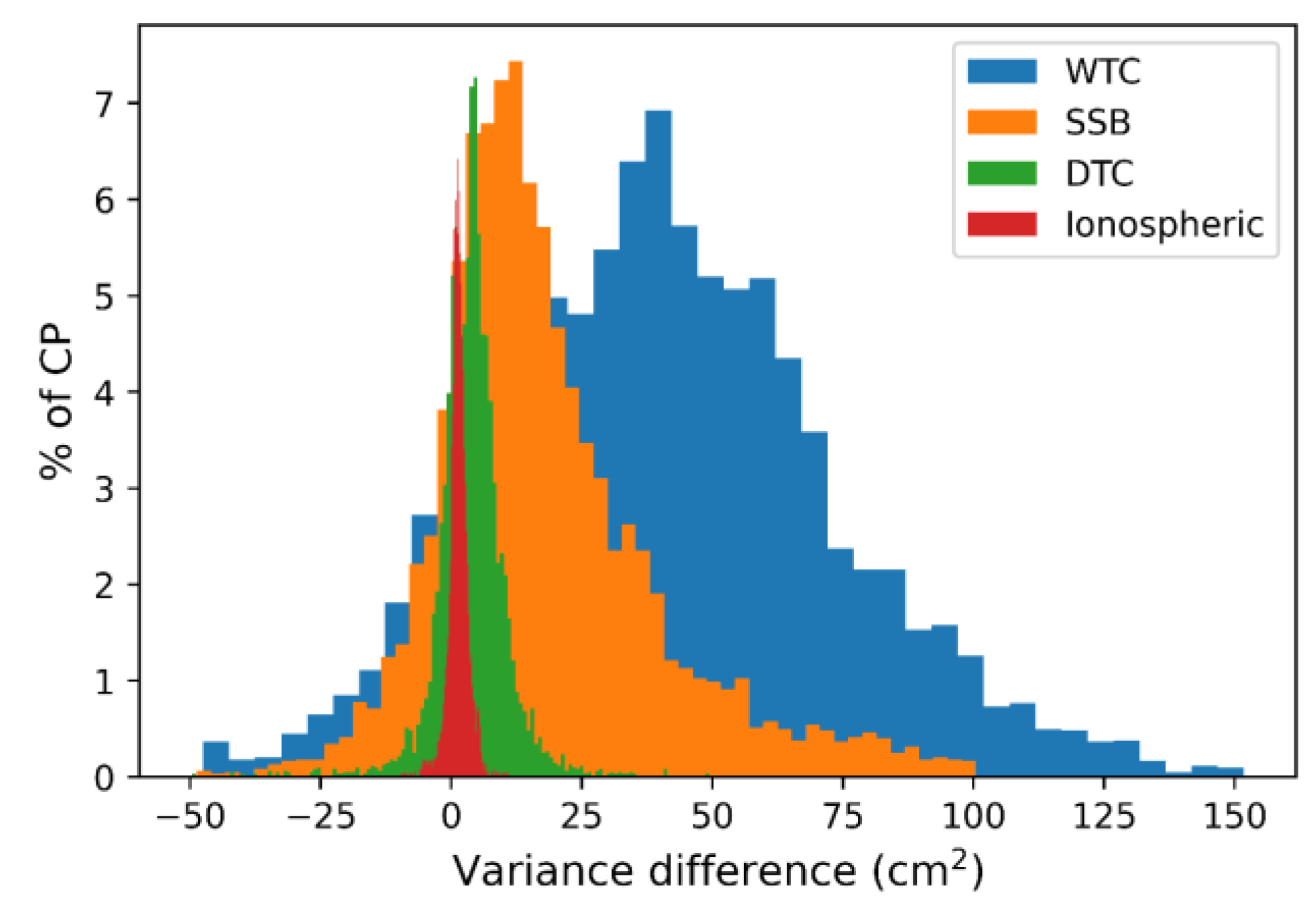
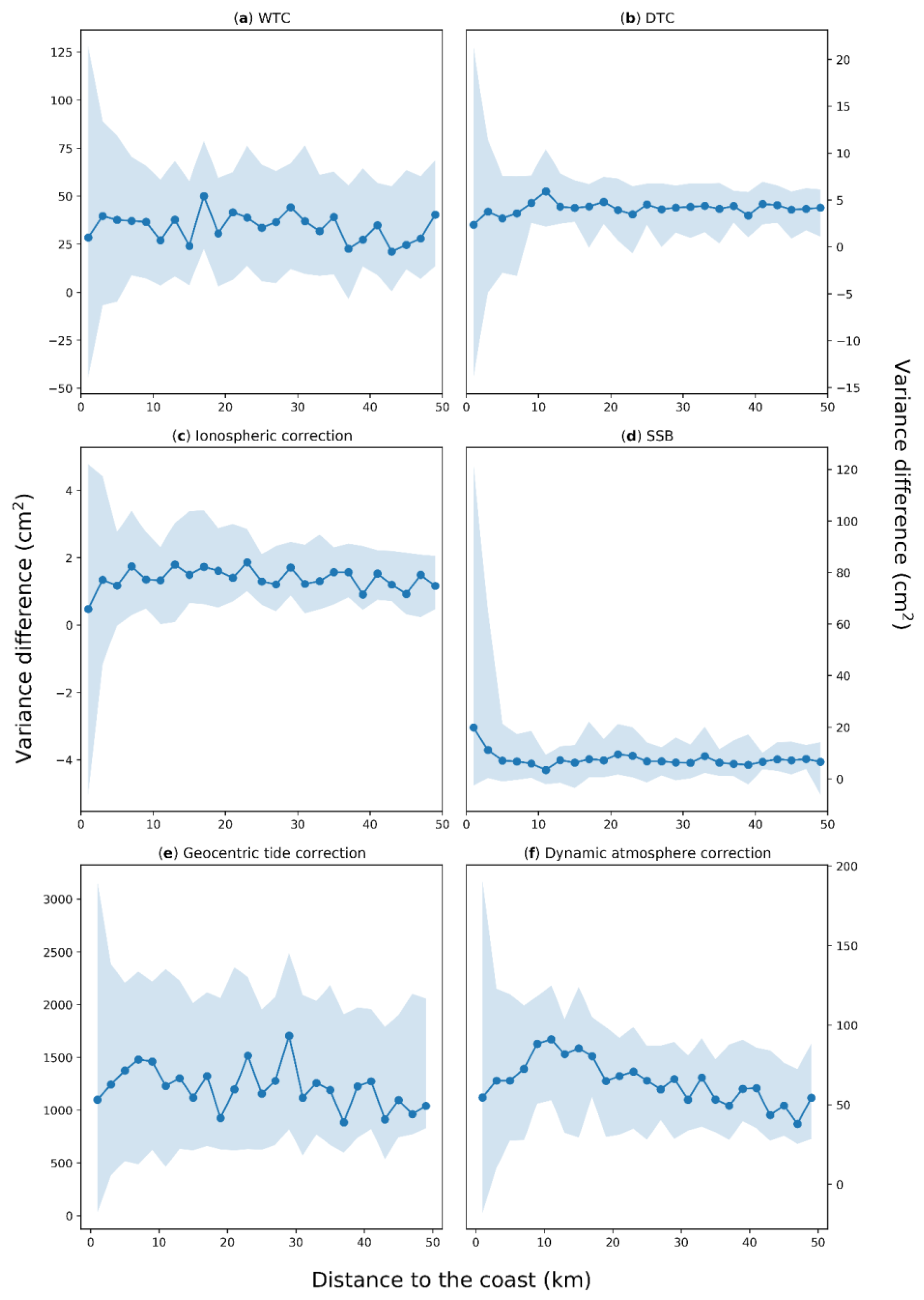
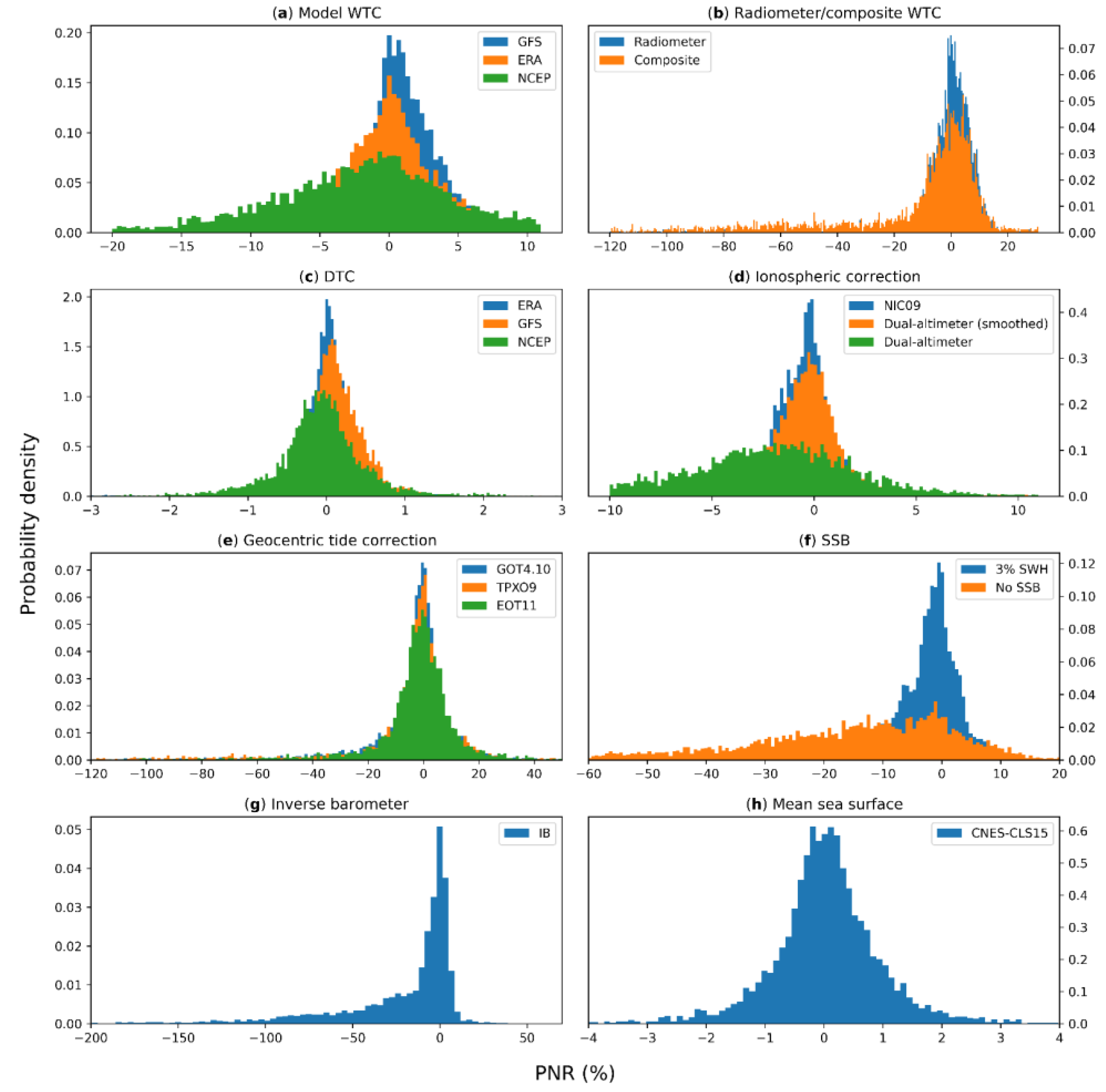
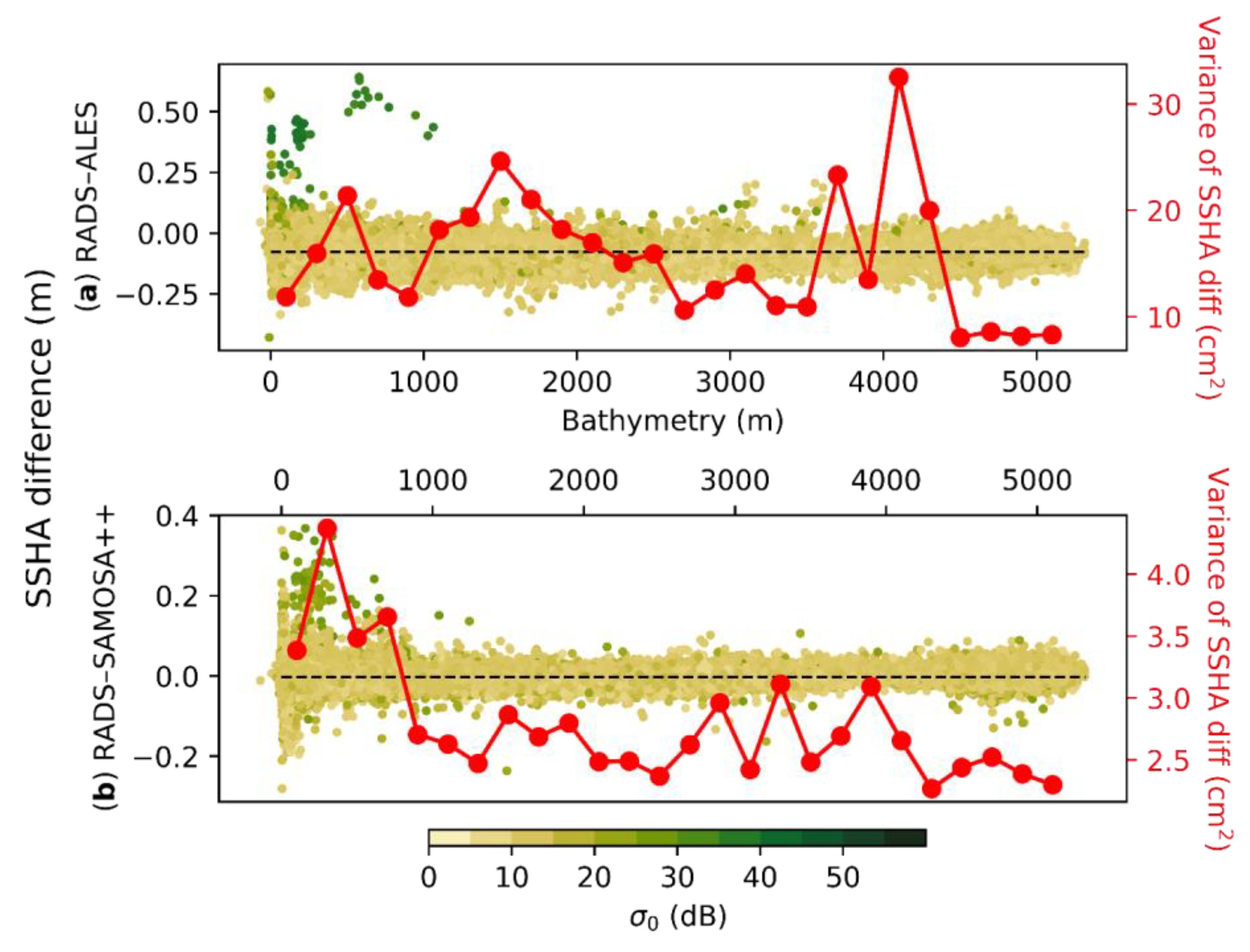
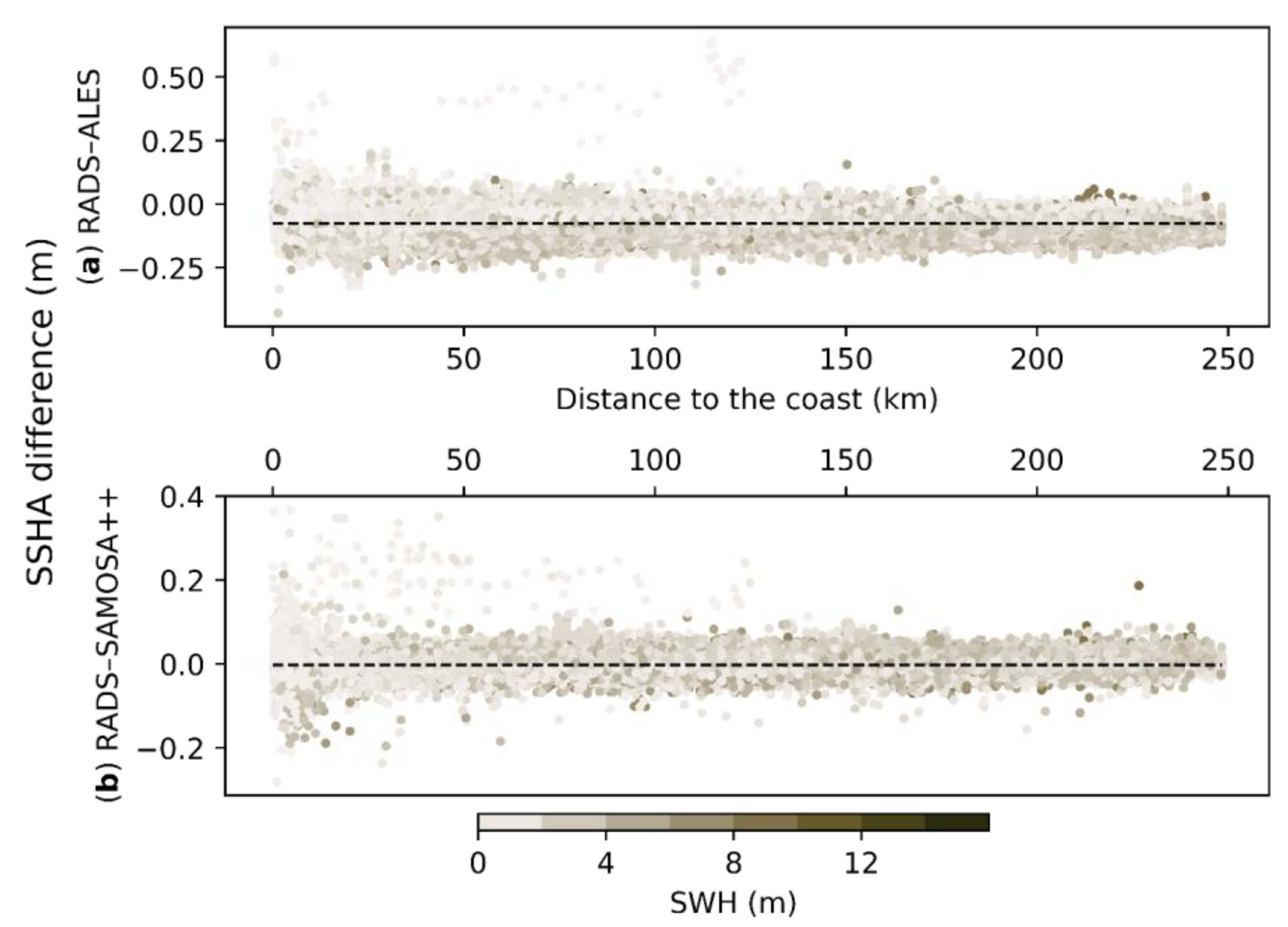
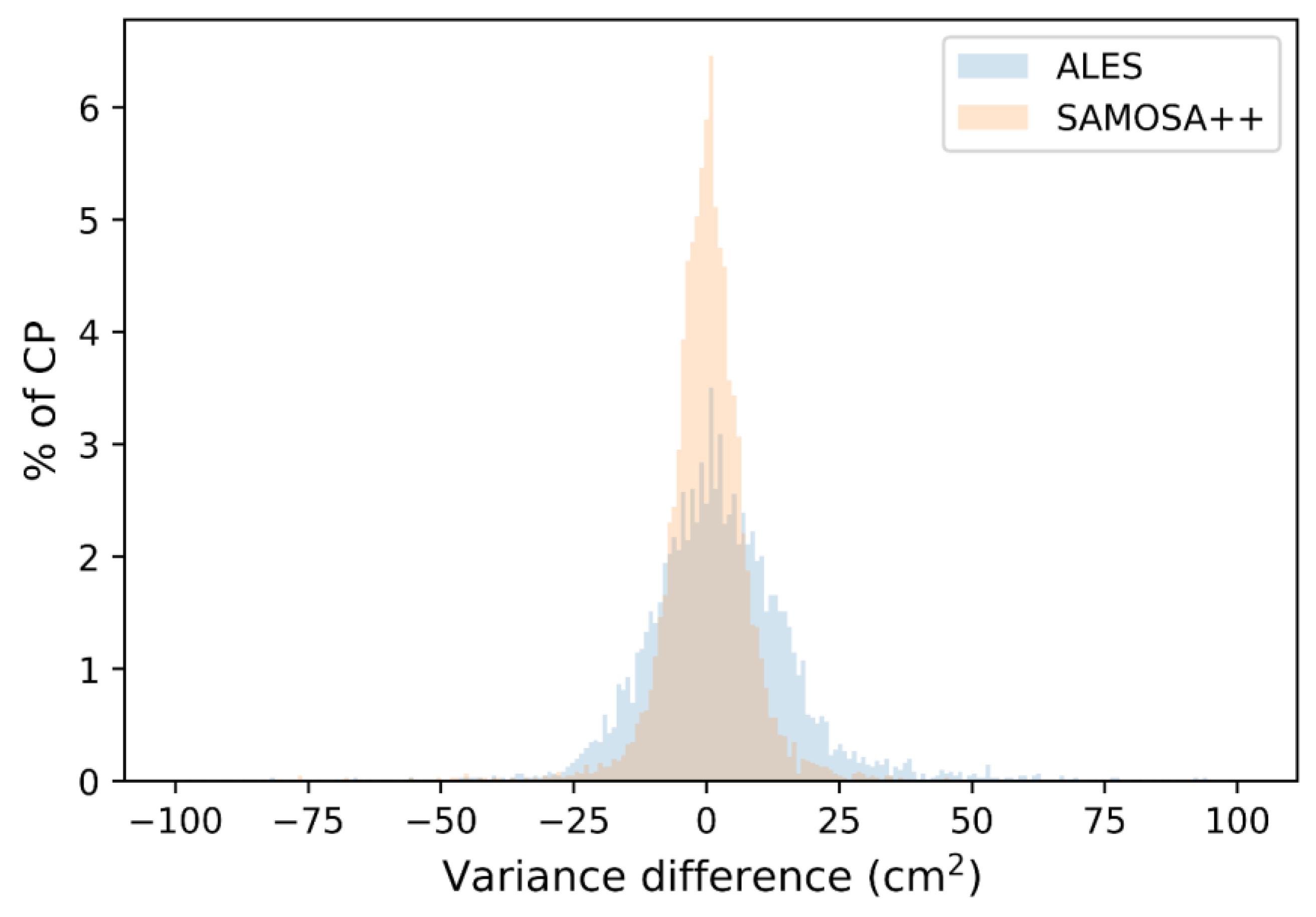

| Product | Source | Cycles | Period Starts | Period Ends |
|---|---|---|---|---|
| RADS | RADS | 1–50 | 1 March 2016 | 26 October 2019 |
| ALES | DGFI-TUM openADB | 25–50 | 24 November 2017 | 26 October 2019 |
| SAMOSA++ | SARvatore for S3 | 5–50 | 15 June 2016 | 26 October 2019 |
| Correction | Correction Product | Comments |
|---|---|---|
| Dry tropospheric correction (DTC) | ECMWF * | |
| ERA-Interim | Only available until 1 August 2019 | |
| GFS | ||
| NCEP | ||
| Wet tropospheric correction (WTC) | ECMWF * | |
| ERA-Interim | Only available until 1 August 2019 | |
| GFS | ||
| NCEP | ||
| Radiometer | ||
| Radiometer (5-comp) | ||
| Composite | ||
| Ionospheric correction | Dual-altimeter | |
| Dual-altimeter (smoothed) | ||
| NIC09 [30] | ||
| GIM * [31] | ||
| Sea state bias (SSB) | CLS Jason-2-based nonparametric * [32,33] | |
| 3% SWH | ||
| Dynamic atmosphere correction (DAC) | MOG2D * [34] | |
| Static IB [35] | ||
| Geocentric tide correction (ocean + load) | FES2014b * [36] | |
| GOT4.10 [37] | ||
| TPXO9v2 [38] | ||
| EOT11a [39] | ||
| Solid Earth tide | Cartwright-Tayler-Edden * [40,41] | |
| Pole tide | Wahr * [42] | |
| MSS | DTU18 * [43] | |
| CNES-CLS15 [44] |
| Product | Spatial Resolution | Temporal Resolution | Source |
|---|---|---|---|
| ECMWF operational analysis | 0.125° × 0.125° | 6 h | [46] |
| ERA-Interim | 1.5° × 1.5° (Gaussian grid 79 km [35]) | 6 h | [46] |
| NCEP/NCAR | 2.5° × 2.5° | 6 h | [47] |
| GFS | 0.25° × 0.25° | 6 h | [48] |
| ERA-5 1 | 0.25° × 0.25° | 1 h | [49] |
| Correction | Median, cm2 | Q1, cm2 | Q3, cm2 | IQR, cm2 | Δvar < 0, % |
|---|---|---|---|---|---|
| Geocentric tide (ocean + load) | 1026 | 669 | 1805 | 1136 | 2 |
| Solid Earth tide | 87 | 60 | 124 | 64 | 3 |
| Pole tide | 0.4 | −1 | 2 | 3 | 42 |
| Dynamic atmosphere | 52 | 29 | 137 | 108 | 4 |
| Wet troposphere | 37 | 14 | 59 | 45 | 13 |
| Sea state bias | 13 | 3 | 28 | 25 | 17 |
| Dry troposphere | 4 | 0 | 7 | 7 | 25 |
| Mean sea surface | 1 | −1 | 3 | 4 | 37 |
| Ionospheric | 1 | 0 | 2 | 2 | 19 |
| Difference | Mean, cm | Standard Deviation, cm | Median, cm |
|---|---|---|---|
| RADS–SAMOSA++ | −0.2 | 1.8 | −0.3 |
| RADS–ALES | −7.6 | 3.6 | −7.6 |
Disclaimer/Publisher’s Note: The statements, opinions and data contained in all publications are solely those of the individual author(s) and contributor(s) and not of MDPI and/or the editor(s). MDPI and/or the editor(s) disclaim responsibility for any injury to people or property resulting from any ideas, methods, instructions or products referred to in the content. |
© 2023 by the authors. Licensee MDPI, Basel, Switzerland. This article is an open access article distributed under the terms and conditions of the Creative Commons Attribution (CC BY) license (https://creativecommons.org/licenses/by/4.0/).
Share and Cite
Abele, A.; Royston, S.; Bamber, J. The Impact of Altimetry Corrections of Sentinel-3A Sea Surface Height in the Coastal Zone of the Northwest Atlantic. Remote Sens. 2023, 15, 1132. https://doi.org/10.3390/rs15041132
Abele A, Royston S, Bamber J. The Impact of Altimetry Corrections of Sentinel-3A Sea Surface Height in the Coastal Zone of the Northwest Atlantic. Remote Sensing. 2023; 15(4):1132. https://doi.org/10.3390/rs15041132
Chicago/Turabian StyleAbele, Anrijs, Sam Royston, and Jonathan Bamber. 2023. "The Impact of Altimetry Corrections of Sentinel-3A Sea Surface Height in the Coastal Zone of the Northwest Atlantic" Remote Sensing 15, no. 4: 1132. https://doi.org/10.3390/rs15041132
APA StyleAbele, A., Royston, S., & Bamber, J. (2023). The Impact of Altimetry Corrections of Sentinel-3A Sea Surface Height in the Coastal Zone of the Northwest Atlantic. Remote Sensing, 15(4), 1132. https://doi.org/10.3390/rs15041132






